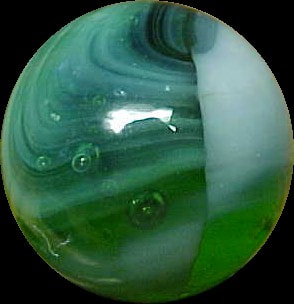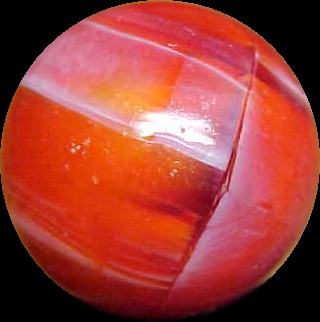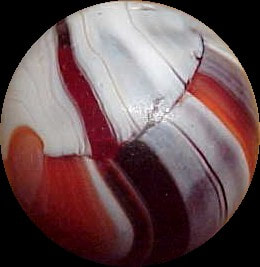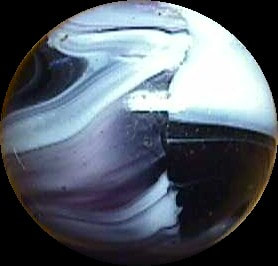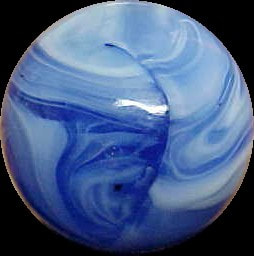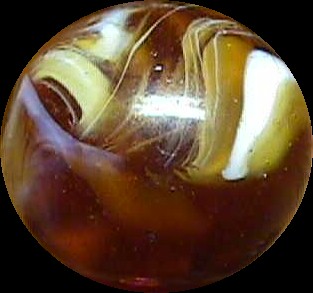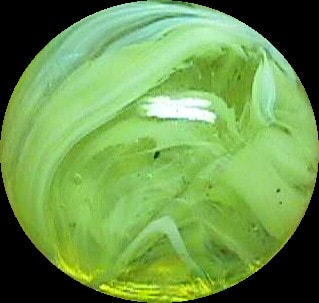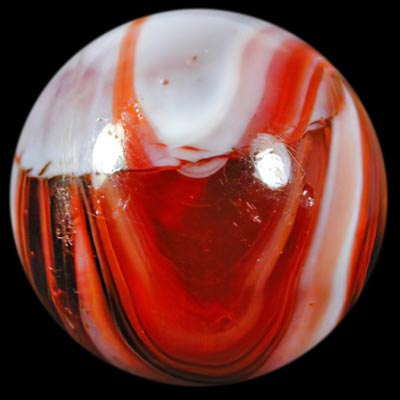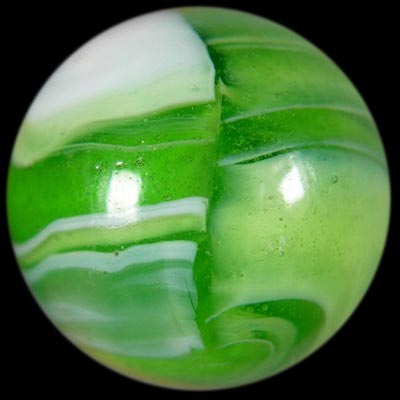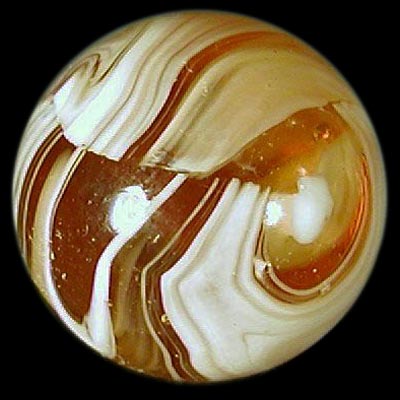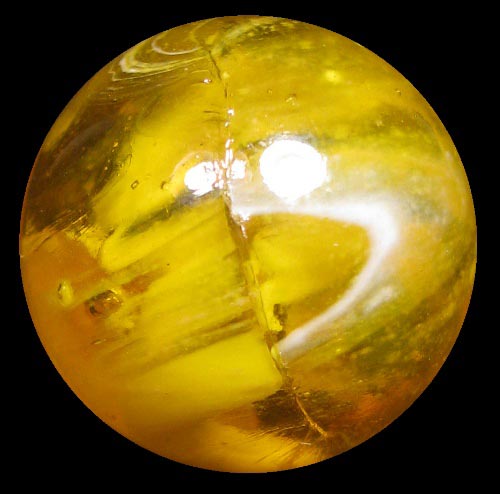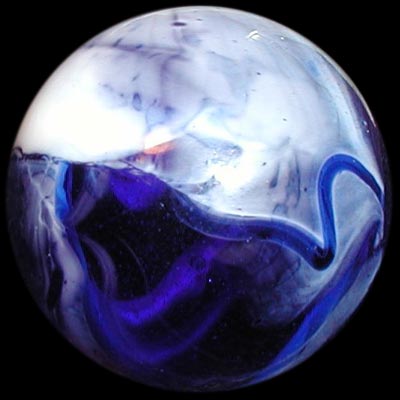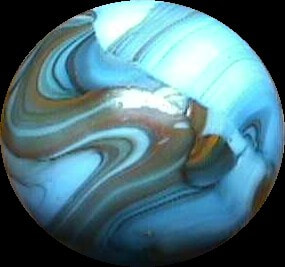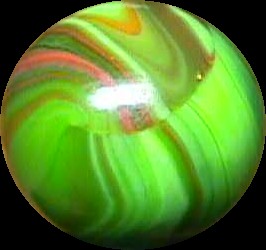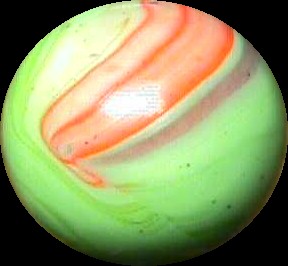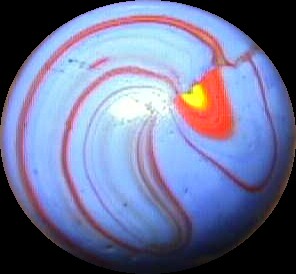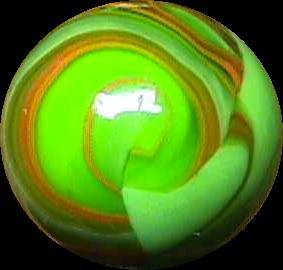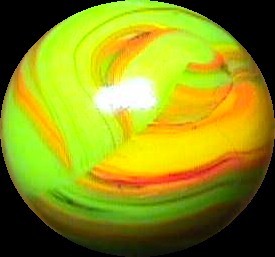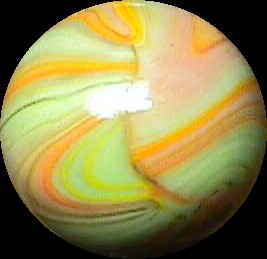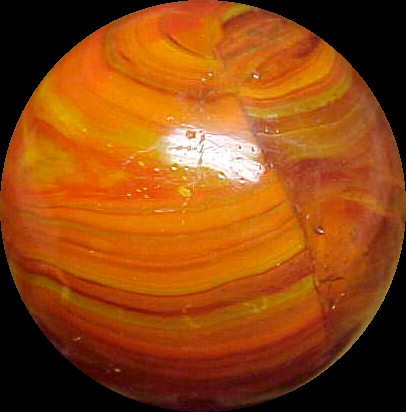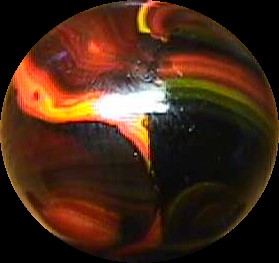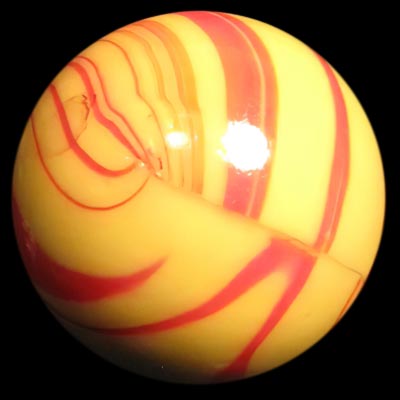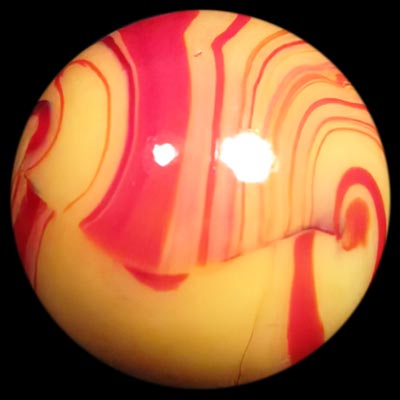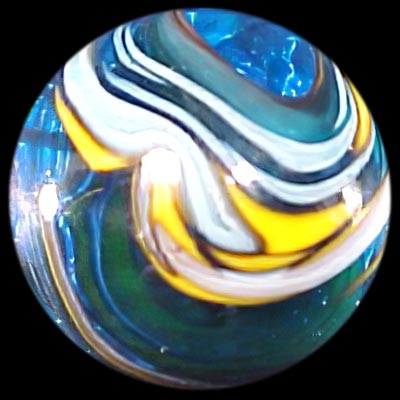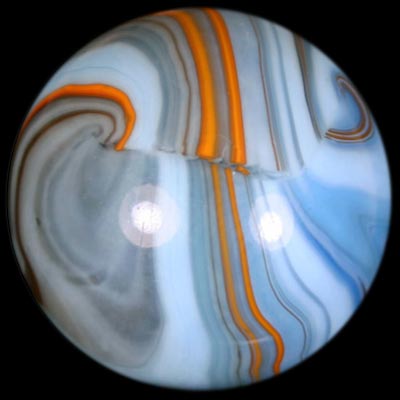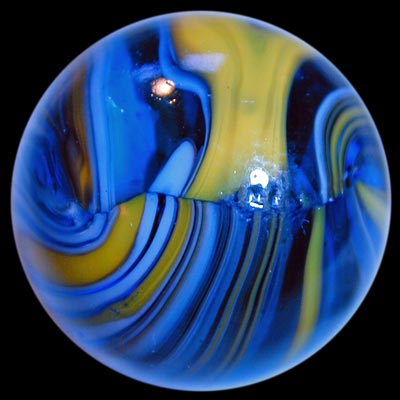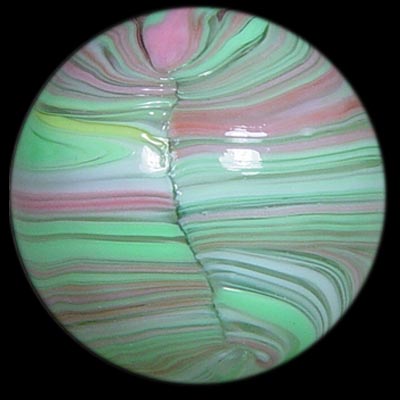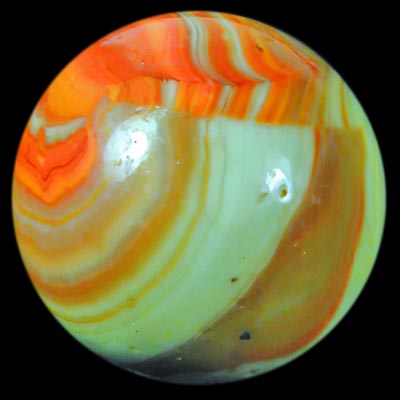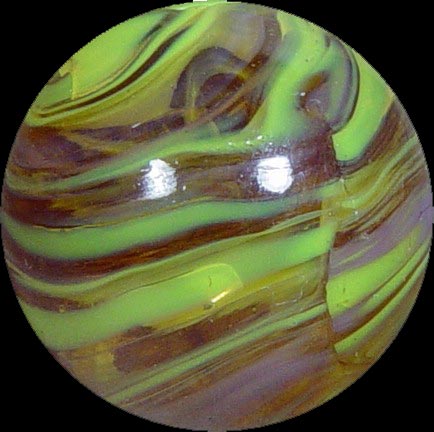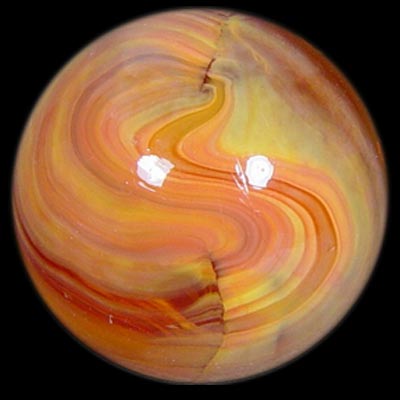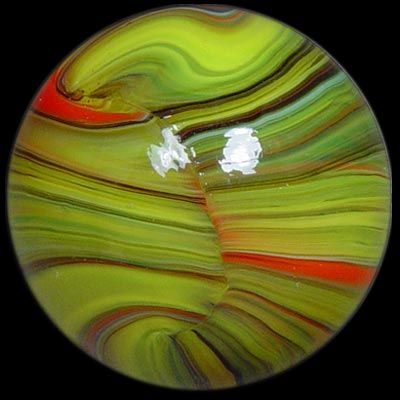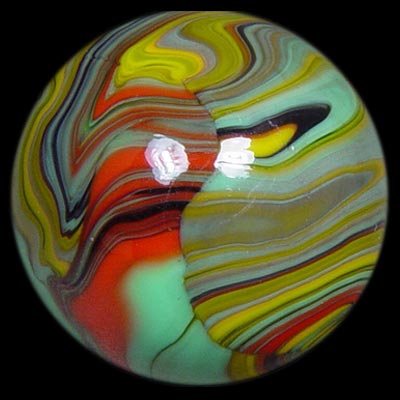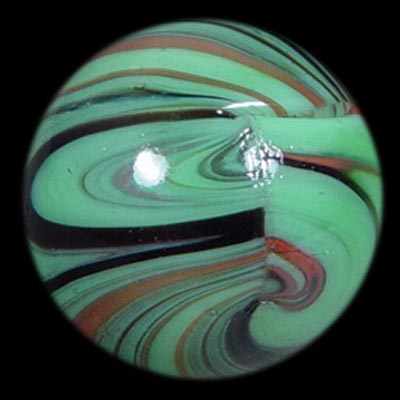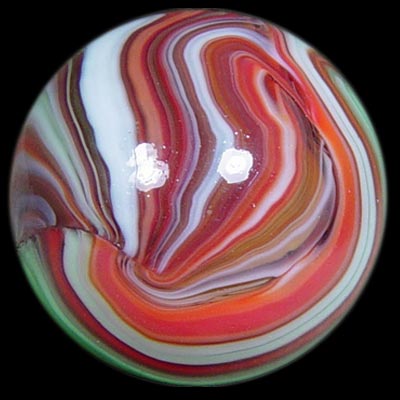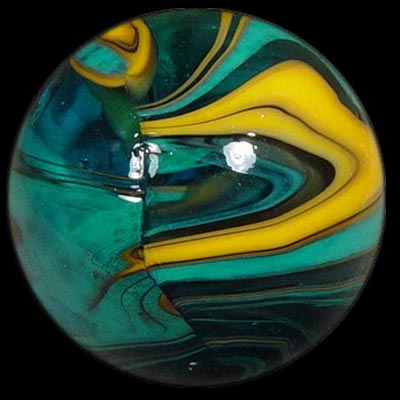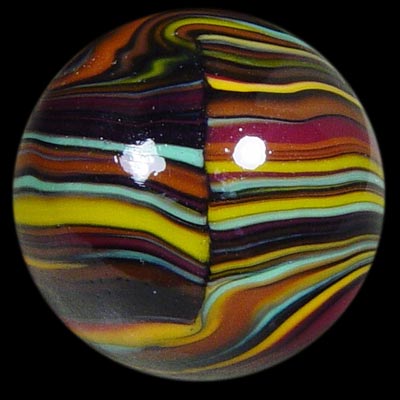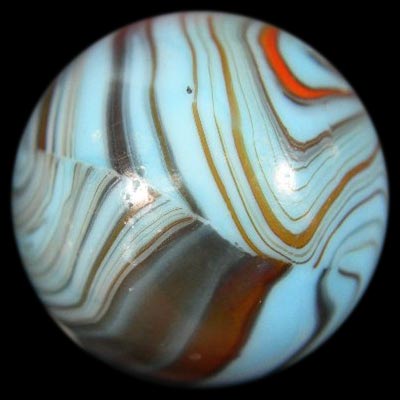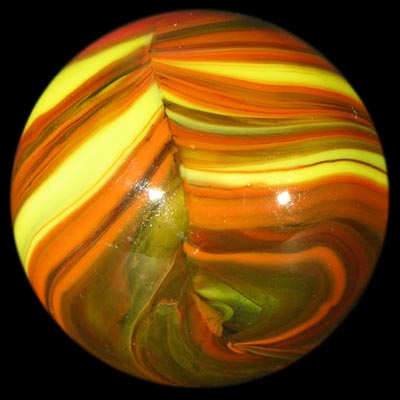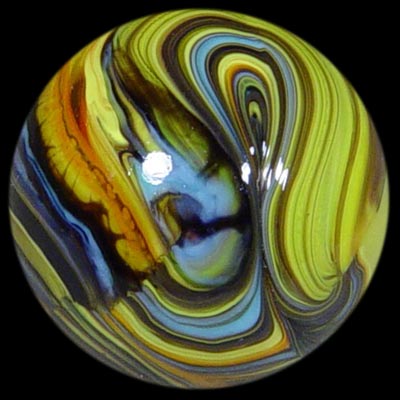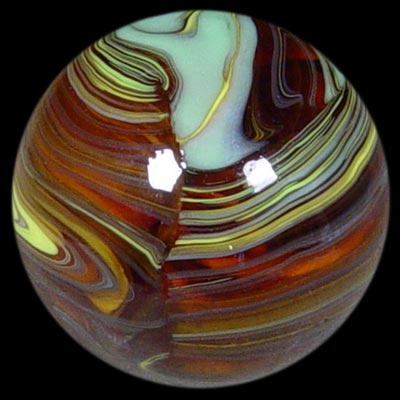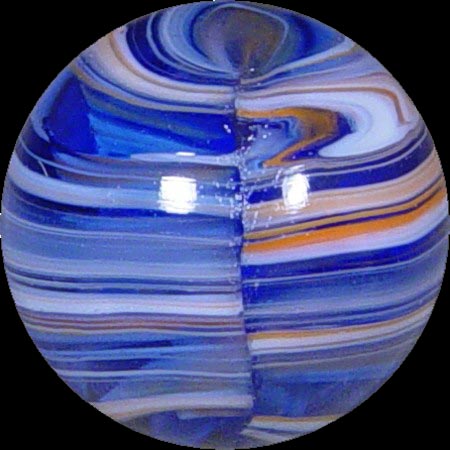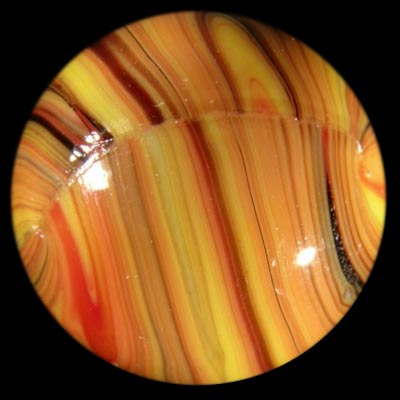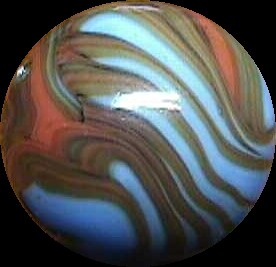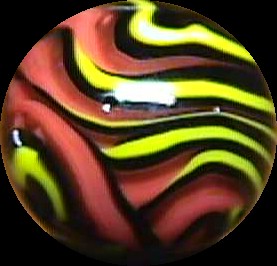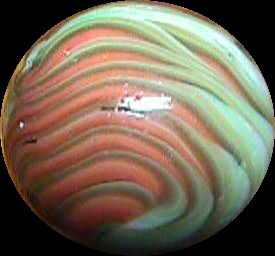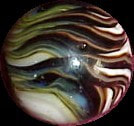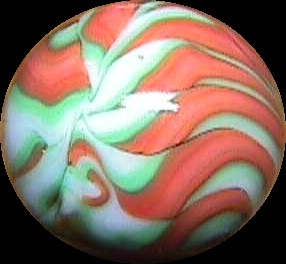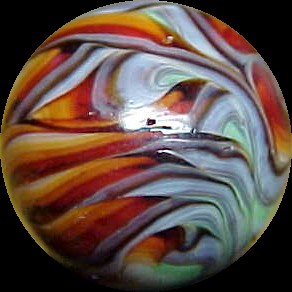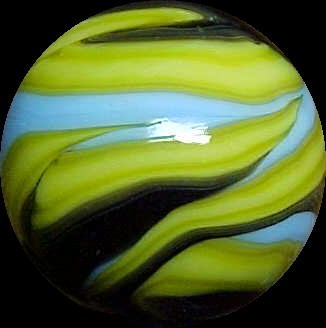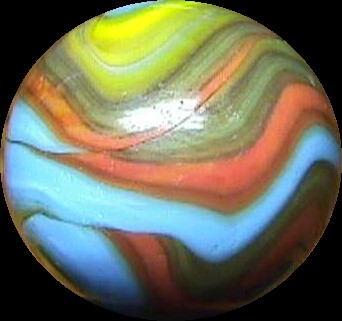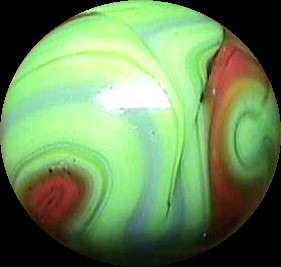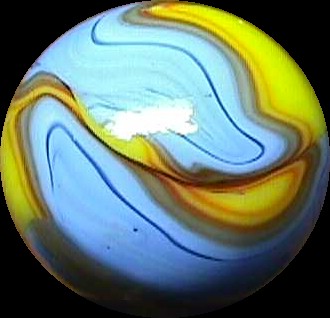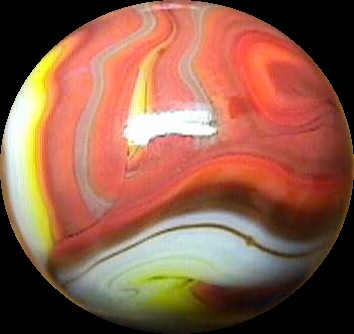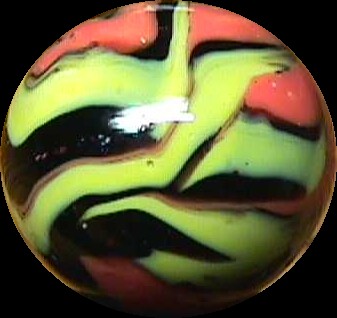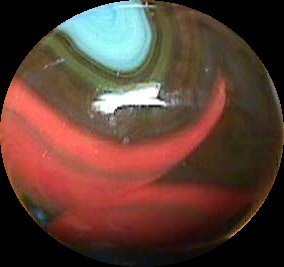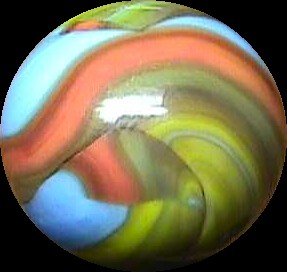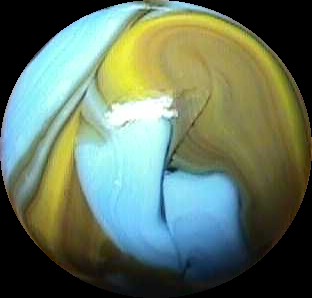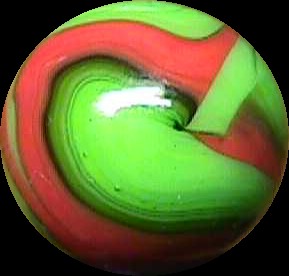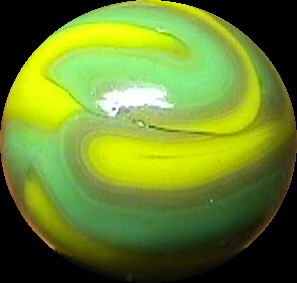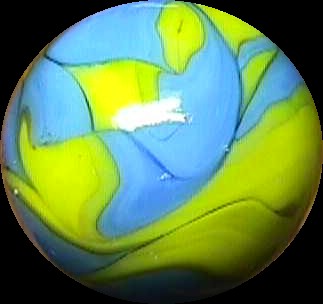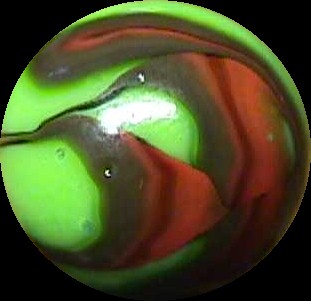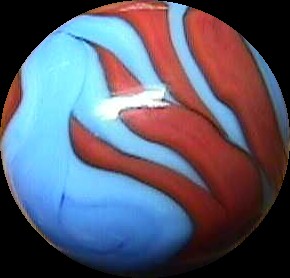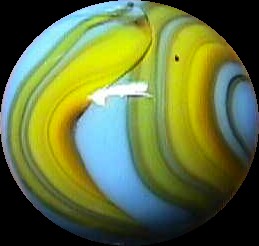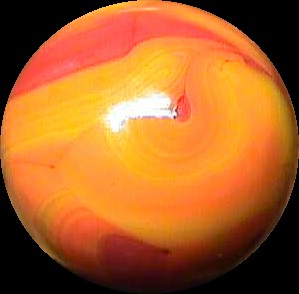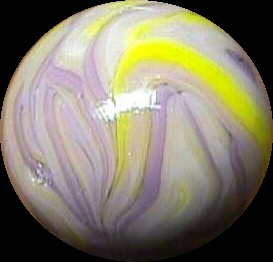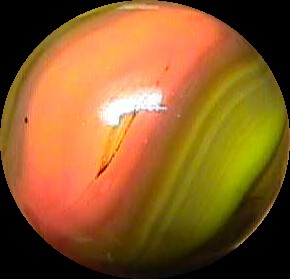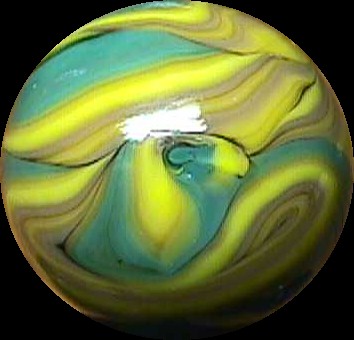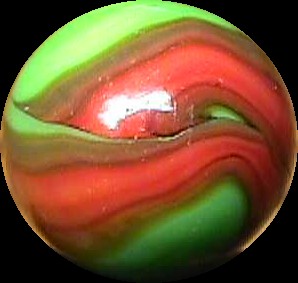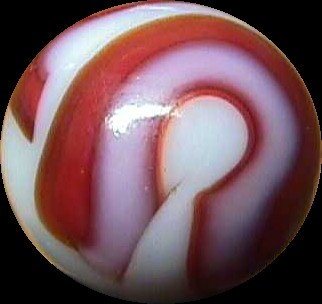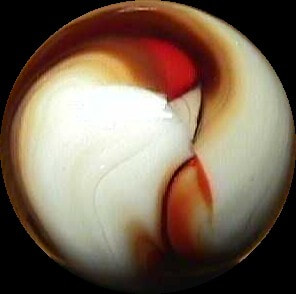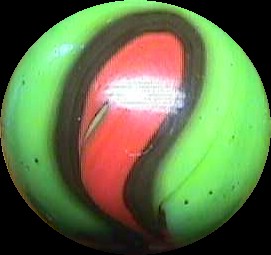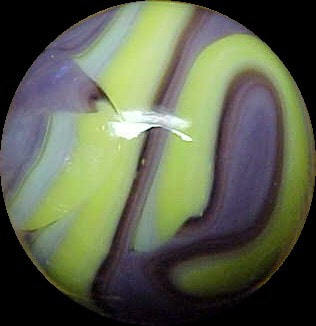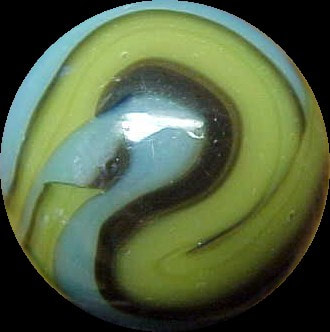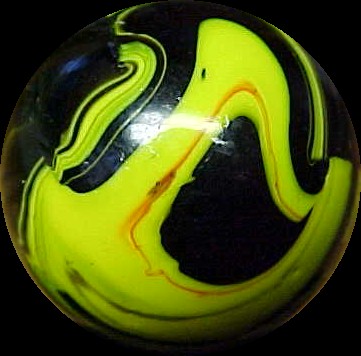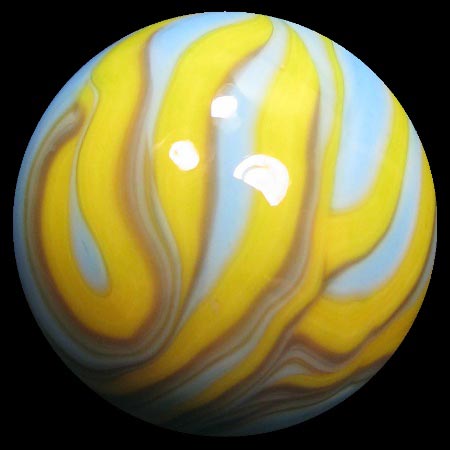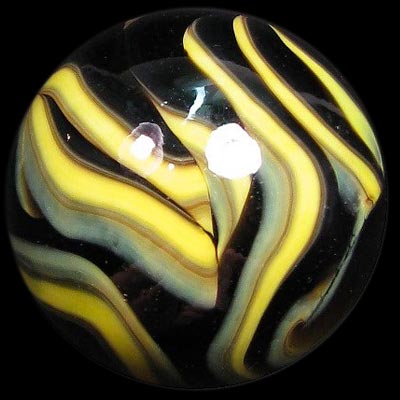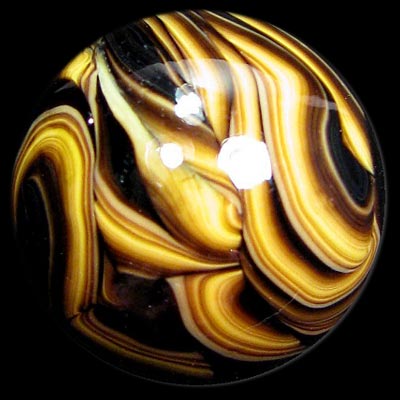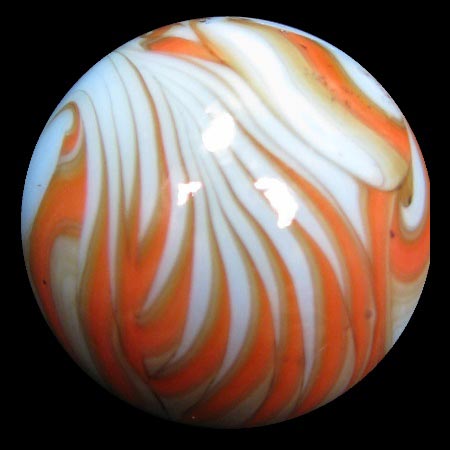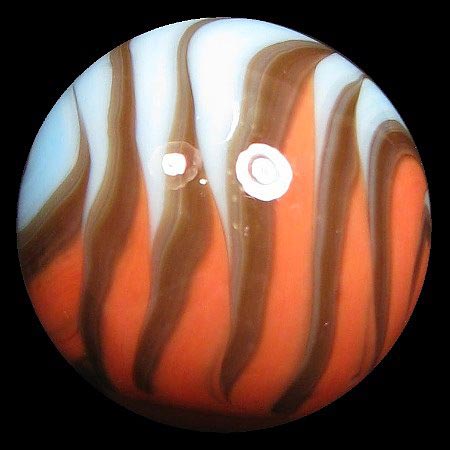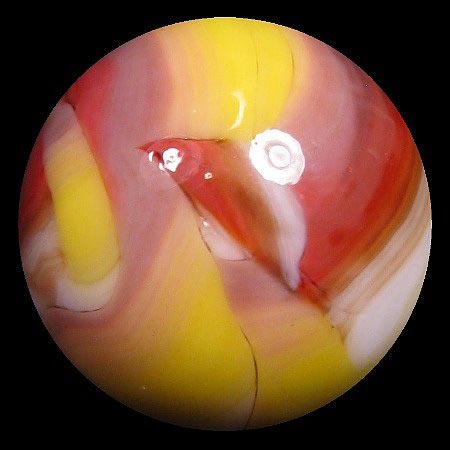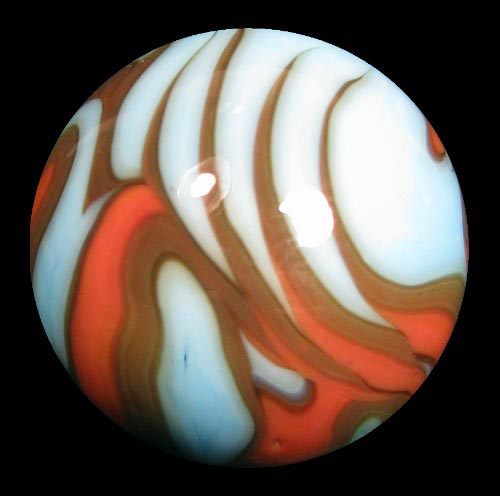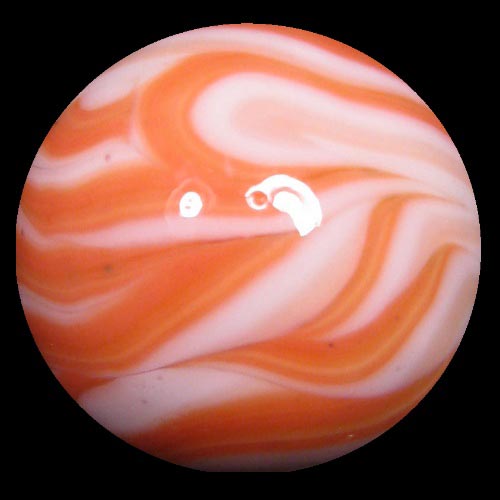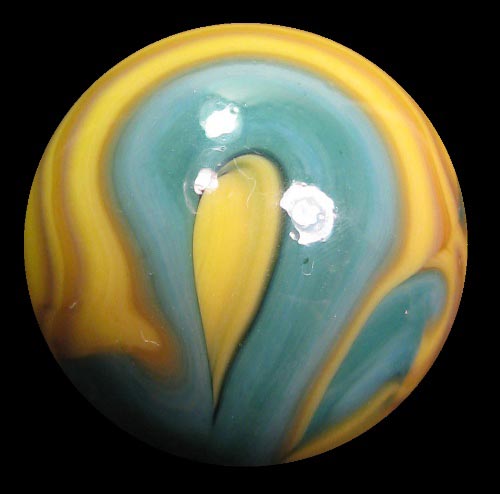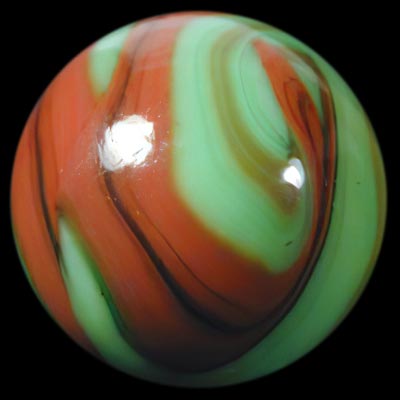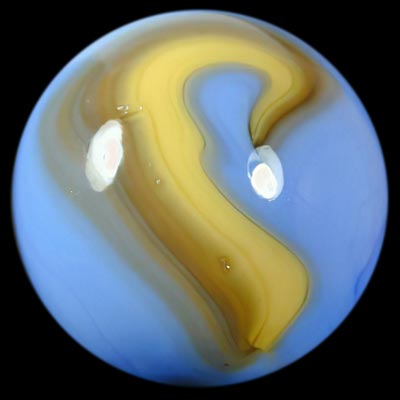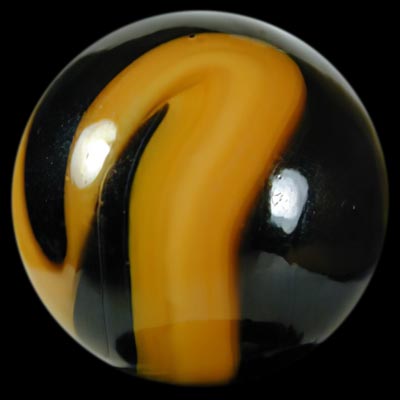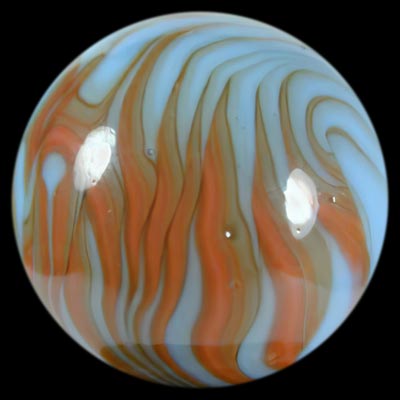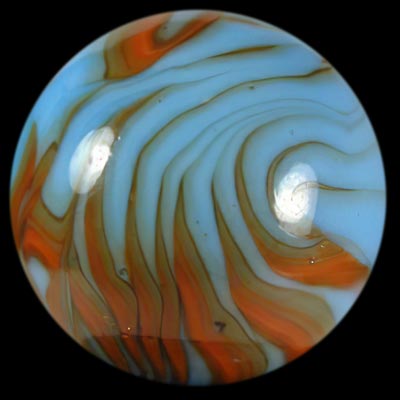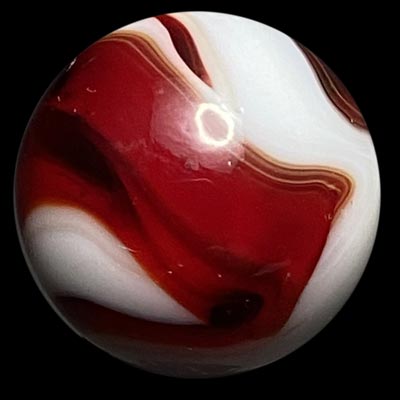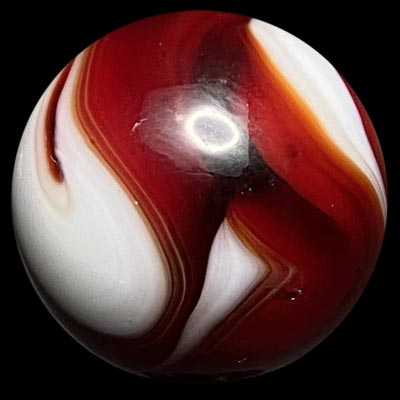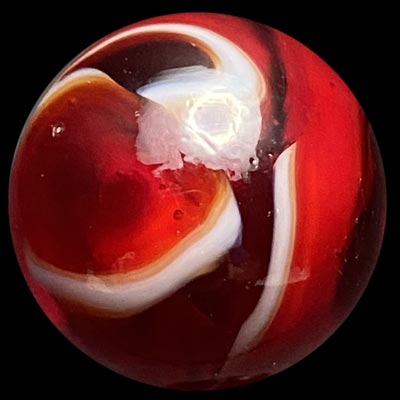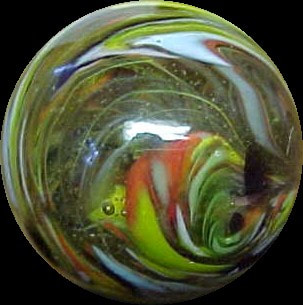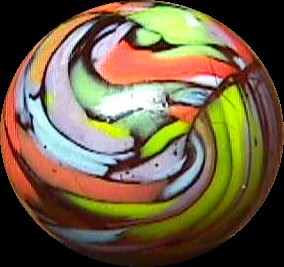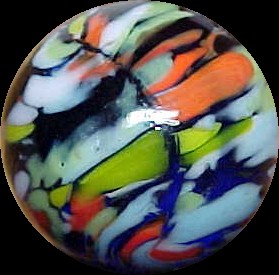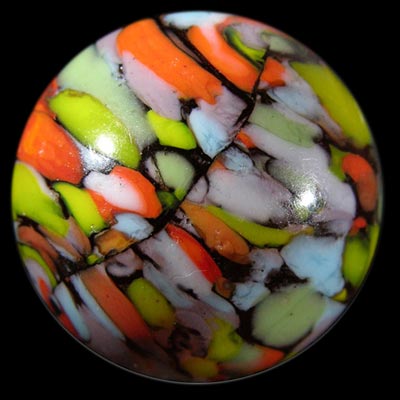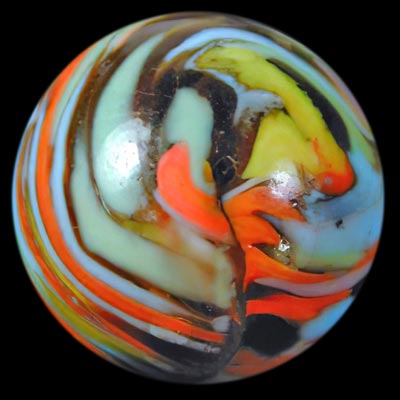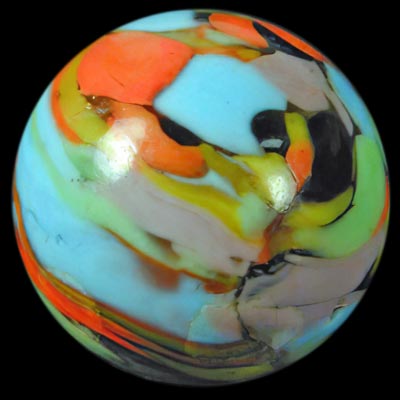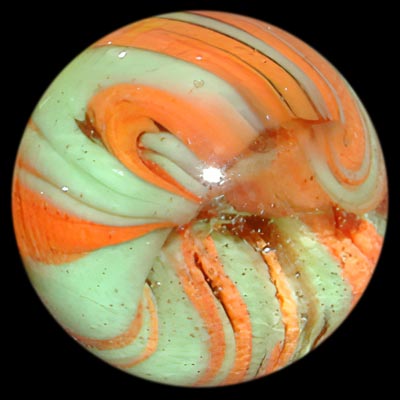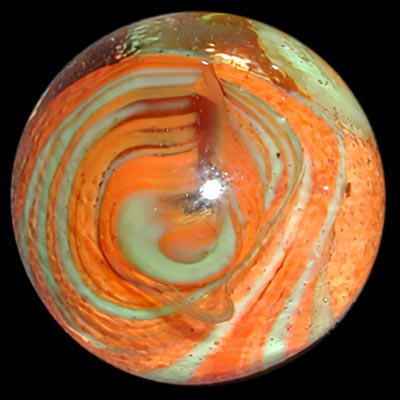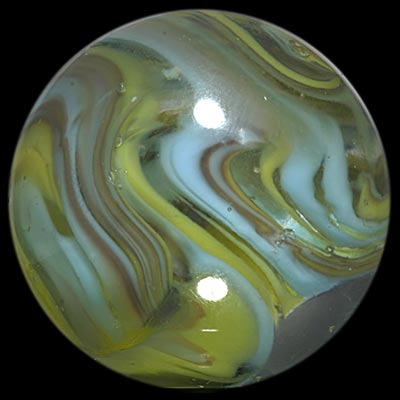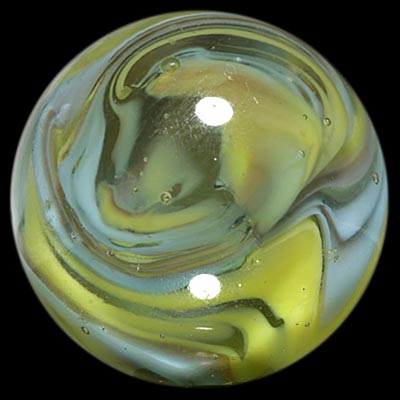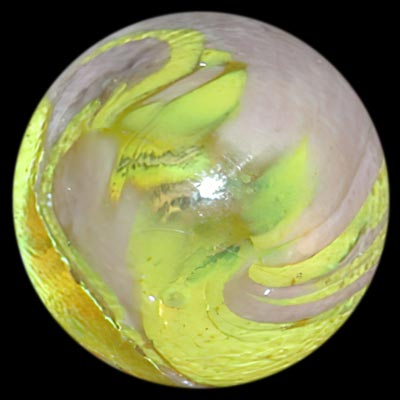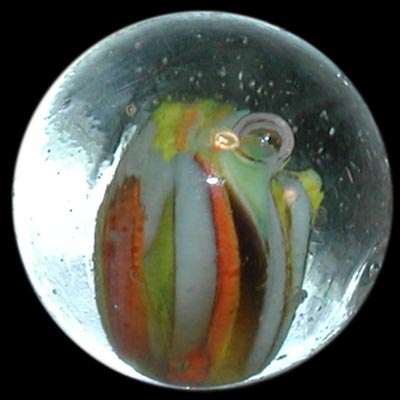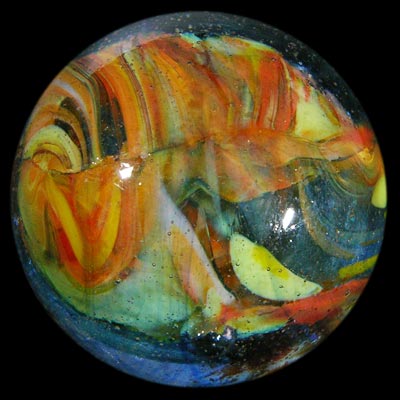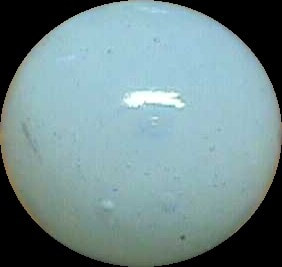christensen AGATE COmpany (1925-1933)
COMPANY HISTORY
The Christensen Agate Company was founded in 1925 but was out of business only eight years later. However brief its career was, it was also spectacular, for the company produced some of the most colorful and beautiful machine made marbles the world would ever see. Much of this should be credited to Arnold Fiedler, who brought with him both expertise and glass formulae obtained during his employment with the nearby Cambridge Glass Company.
The Christensen Agate Company was initially located in Payne, Ohio, but shifted its operations to Cambridge, Ohio, in 1927, where it occupied a small brick building on Bennett Avenue, adjacent to the Cambridge Glass Company, from whom it purchased scrap glass. Here, it produced, like M.F. Christensen (from whom it took its name, perhaps because the Christensen name was well-known), only single-stream marbles.
The Christensen Agate Company was founded by W.F. Jones, H.H. Culper, Owen M. Roderick, Robert C. Ryder, and Beaulah P. Hartman. However, the two individuals who made the company's marbles as distinctive as they are were the aforementioned glass chemist Arnold Fiedler, who later became the head of the company, and Howard M. Jenkins, who was president of Christensen Agate and also manufactured and patented its marble-making machinery. This patent was obtained in 1924; however, there is little that can be said about the first marbles produced by this machinery while operating in the factory's original location in Payne.
At the Cambridge location, Christensen Agate began producing the marbles for which it is so well known. Fiedler used his innovative techniques and skills learned in Germany and later refined at Cambridge Glass to lend to the marbles their unique coloration. When Christensen Agate closed its doors in 1933, two years after the actual cessation of marble manufacture, Fiedler had already shifted his employment to Akro Agate, which explains why early Akro marbles possess many of the same colors seen in Christensen's marbles.
Today, Christensen marbles are rare. One reason is because the company was in operation for a very short time, perhaps in peak activity only four years at the Cambridge location. Since the factory could only produce some 600,000 marbles each day, probably an estimate of 400,000,000 marbles made in Cambridge is a reasonable assumption. This may seem like an abundance of marbles, but given the fact that over 65 years have elapsed since the factory closed its doors one can imagine that through loss and breakage it is no wonder they are so difficult to come by.
The Christensen Agate Company was founded in 1925 but was out of business only eight years later. However brief its career was, it was also spectacular, for the company produced some of the most colorful and beautiful machine made marbles the world would ever see. Much of this should be credited to Arnold Fiedler, who brought with him both expertise and glass formulae obtained during his employment with the nearby Cambridge Glass Company.
The Christensen Agate Company was initially located in Payne, Ohio, but shifted its operations to Cambridge, Ohio, in 1927, where it occupied a small brick building on Bennett Avenue, adjacent to the Cambridge Glass Company, from whom it purchased scrap glass. Here, it produced, like M.F. Christensen (from whom it took its name, perhaps because the Christensen name was well-known), only single-stream marbles.
The Christensen Agate Company was founded by W.F. Jones, H.H. Culper, Owen M. Roderick, Robert C. Ryder, and Beaulah P. Hartman. However, the two individuals who made the company's marbles as distinctive as they are were the aforementioned glass chemist Arnold Fiedler, who later became the head of the company, and Howard M. Jenkins, who was president of Christensen Agate and also manufactured and patented its marble-making machinery. This patent was obtained in 1924; however, there is little that can be said about the first marbles produced by this machinery while operating in the factory's original location in Payne.
At the Cambridge location, Christensen Agate began producing the marbles for which it is so well known. Fiedler used his innovative techniques and skills learned in Germany and later refined at Cambridge Glass to lend to the marbles their unique coloration. When Christensen Agate closed its doors in 1933, two years after the actual cessation of marble manufacture, Fiedler had already shifted his employment to Akro Agate, which explains why early Akro marbles possess many of the same colors seen in Christensen's marbles.
Today, Christensen marbles are rare. One reason is because the company was in operation for a very short time, perhaps in peak activity only four years at the Cambridge location. Since the factory could only produce some 600,000 marbles each day, probably an estimate of 400,000,000 marbles made in Cambridge is a reasonable assumption. This may seem like an abundance of marbles, but given the fact that over 65 years have elapsed since the factory closed its doors one can imagine that through loss and breakage it is no wonder they are so difficult to come by.
IDENTIFICATION TIPS
Christensen Agate marbles were produced by machinery that only made single-stream marbles. In their swirls, multiple color marbles were created not by variegated-stream machinery but by mixing the different colors of glass together. The various colors had different consistencies and therefore remained separate for the most part, instead of blending together. Few Christensen Agate marbles will manifest the blending of colors so often seen on later marbles, such as Akro Agates. Also, many Christensen marbles, particularly those with opaque colors, are identifiable due to their unique coloring. Thanks to the skills of Arnold Fiedler, Christensen colors are distinguishable from those of other companies, and once you have seen them you will not mistake non-Christensen marbles from those made by the company during its brief existence. Most Christensen Agate marbles will have a diameter of under 25/32". Any larger than this are considered very rare and none have yet been found that are over one inch.
SLAGS
Like most marble companies of the day, Christensen produced slags (in blue, aqua, green, brown, clear, purple, red, orange, yellow, and peach---the latter color is unique to Christensen). Christensen slags are identifiable by their seams; they may have two or they may have only one. They can be differentiated from Peltier slags because they do not have the fine "feathering" of the white glass that the latter possess. The white swirls occur on the surface of the marble as well inside it. However, if the white is primarily on the surface, and forms bands running over one side of the marble and terminating at a seam, then the marble is considered a Striped Transparent (see below).
Christensen Agate marbles were produced by machinery that only made single-stream marbles. In their swirls, multiple color marbles were created not by variegated-stream machinery but by mixing the different colors of glass together. The various colors had different consistencies and therefore remained separate for the most part, instead of blending together. Few Christensen Agate marbles will manifest the blending of colors so often seen on later marbles, such as Akro Agates. Also, many Christensen marbles, particularly those with opaque colors, are identifiable due to their unique coloring. Thanks to the skills of Arnold Fiedler, Christensen colors are distinguishable from those of other companies, and once you have seen them you will not mistake non-Christensen marbles from those made by the company during its brief existence. Most Christensen Agate marbles will have a diameter of under 25/32". Any larger than this are considered very rare and none have yet been found that are over one inch.
SLAGS
Like most marble companies of the day, Christensen produced slags (in blue, aqua, green, brown, clear, purple, red, orange, yellow, and peach---the latter color is unique to Christensen). Christensen slags are identifiable by their seams; they may have two or they may have only one. They can be differentiated from Peltier slags because they do not have the fine "feathering" of the white glass that the latter possess. The white swirls occur on the surface of the marble as well inside it. However, if the white is primarily on the surface, and forms bands running over one side of the marble and terminating at a seam, then the marble is considered a Striped Transparent (see below).
CHRISTENSEN AGATE SLAGS GALLERY
(Hover your mouse or lightly touch the image to see the type of marble. Click to view the full size image)
(Hover your mouse or lightly touch the image to see the type of marble. Click to view the full size image)
STRIPED OPAQUES / STRIPED TRANSPARENTS
Christensen Striped Opaques and Striped Transparents both share a common trait and are only differentiated based on their base glass (opacity vs. transparency). Both will have a base of one color, on top of which there will be one or more opaque colors forming stripes across the surface, running from one side of the marble and terminating on the other at a seam. Often the point of origin is another seam that is also very obvious, though sometimes it is not so noticeable. More often than not, the stripes on these marbles will be "electric," that is, they will be especially vibrant.
One additional type of Christensen swirl, and an extremely rare one at that, is the "layered sand." This is called such because of the way the strata in the glass formed. These strata are even finer than seen in flames and in fact the marble will bear a striking resemblance to the layers of different colored sand one used to see in aquariums and glass frames. In fact, most Layered Sand swirls will have more than two colors, and these are frequently electric. There are few machine made marbles as difficult to find than this type.
Christensen Striped Opaques and Striped Transparents both share a common trait and are only differentiated based on their base glass (opacity vs. transparency). Both will have a base of one color, on top of which there will be one or more opaque colors forming stripes across the surface, running from one side of the marble and terminating on the other at a seam. Often the point of origin is another seam that is also very obvious, though sometimes it is not so noticeable. More often than not, the stripes on these marbles will be "electric," that is, they will be especially vibrant.
One additional type of Christensen swirl, and an extremely rare one at that, is the "layered sand." This is called such because of the way the strata in the glass formed. These strata are even finer than seen in flames and in fact the marble will bear a striking resemblance to the layers of different colored sand one used to see in aquariums and glass frames. In fact, most Layered Sand swirls will have more than two colors, and these are frequently electric. There are few machine made marbles as difficult to find than this type.
STRIPED OPAQUES / TRANSPARENTS GALLERY
(Hover your mouse or lightly touch the image to see the type of marble. Click to view the full size image)
(Hover your mouse or lightly touch the image to see the type of marble. Click to view the full size image)
SWIRLS & FLAMES
Christensen Agate swirls are among the most collectible machine made marbles, not only because they are often so beautiful and colorful, but also because they are fairly rare. White-based examples often go unnoticed because these swirls can easily be mistaken for the swirls of later companies, but the color-based ones are very easy to recognize. On the opaque swirls there is much more variety, and the marbles may have as many as five different colors. Infrequently, one or more of the colors in an opaque swirl will be transparent.
Transparent swirls are more rare than opaque swirls and are more limited in their color combinations. Typically, colors in a transparent base will be electric yellow or orange, and the base is usually clear, green, blue, or yellow. Electric transparent swirls often have one or two seams, with the colors forming stripes such as those on Striped Transparents, but with the colors under the surface. Other transparent swirls have one or more colors forming a "U" or "V" inside the glass. The clear glass on such swirls often has a syrup-like effect, looking much like glycerin or corn syrup. However, this trait is often seen on transparent-based Akro Agate marbles, too.
On rare occasions, because the molten glass mixed to form the swirls formed strata (owing to the varying densities of the different colors), Christensen swirls formed "flames," so-called because the color strata actually appears on the surface of the marble as fine flames. Most collectors seem to agree that in order to be considered a flame, a marble must have at least four "stacked" flames. Some swirls have so many flames that they can hardly be counted, and when this trait combines with a multicolored swirl the effect can be nothing less than spectacular. Such a marble can fetch upwards of a thousand dollars, and even more if the marble is large, too.
Besides the flames, there are specialized types of swirls named by the company itself. The "bloodie" is one such marble. This marble will always have a dark ruby red transparent base, with opaque white swirls that run from the surface throughout the marble. These are rare, and often hasty collectors will think they own one when in fact the marble is something entirely different (often Ravenswood swirls with these same colors are thought to be Bloodies). It is good for a collector to own a genuine Bloodie, not only because they are beautiful, but because the type is so diagnostic that one can compare its white base to other marbles in order to gain an eye for the subtle difference in Christensen's white glass as compared to that of other companies. (very bright white)
Another named swirl is the American Agate. These marbles will have either an opaque white base or an opalescent white base (opalescent glass is translucent and will glow orange when held to a light). Mixed in with the white are swirls of translucent electric red to transparent electric orange. Therefore, American Agates have a degree of variation in them and one can find several combinations of the colors. The giveaway is the electric swirling. If the swirls are not this bright red or orange, then the marble is just a swirl.
Other names have been thrown around by collectors for Christensen swirl varieties. Few of these have gained recognition and remain as obscure terms, known only to a few. Such types include "Blue Laces" (transparent amber with light blue), "Bluebells" (light transparent blue and opaque white), "Blue Azurites," Jennies," "Submarines" (transparent green and yellow and/or red), "Tanks" (transparent green and brown), "Blue Rays" (transparent cobalt blue with opaque bright orange), "Orange Peels" (black opaque base with orange and yellow patch), "Blue Devils" (transparent cobalt blue with white and yellow patch), "Red Devils" (transparent red with yellow patch), "Figers" (opaque yellow, orange, green, and brown), "Rockets" (translucent black and orange), and so forth.
Usually the swirling on Christensen swirls is random, excepting flames and Layered Sand examples. Quite often, however, the swirls will form a loop known to collectors as a "turkey." These truly do resemble the head of a turkey, in that they swirl upward from an oblique angle, then loop back around in the opposite direction, and finally parallel the beginning of the swirl. Rarely, turkey swirls will even have an "eye" of a third color.
Recently, numerous marbles have appeared which possess the colors of Christensen swirls but are hand-gathered. Some Christensen slags are also hand-gathered. In both cases there will be the "nine and tail" characteristic of "transitional" marbles. It appears that many of the hand-gathered swirls have the colors of American Agates and therefore this may have been one of the first marbles produced by the company.
One last note about Christensen Agate swirls is their lack of seams. Seamed examples are known as Striped Opaques or Striped Transparents. On exception is called a "Diaper Fold." In these, there will be a single seam, and this will form an indention into the marble, into which the swirls extend.
Christensen Agate swirls are among the most collectible machine made marbles, not only because they are often so beautiful and colorful, but also because they are fairly rare. White-based examples often go unnoticed because these swirls can easily be mistaken for the swirls of later companies, but the color-based ones are very easy to recognize. On the opaque swirls there is much more variety, and the marbles may have as many as five different colors. Infrequently, one or more of the colors in an opaque swirl will be transparent.
Transparent swirls are more rare than opaque swirls and are more limited in their color combinations. Typically, colors in a transparent base will be electric yellow or orange, and the base is usually clear, green, blue, or yellow. Electric transparent swirls often have one or two seams, with the colors forming stripes such as those on Striped Transparents, but with the colors under the surface. Other transparent swirls have one or more colors forming a "U" or "V" inside the glass. The clear glass on such swirls often has a syrup-like effect, looking much like glycerin or corn syrup. However, this trait is often seen on transparent-based Akro Agate marbles, too.
On rare occasions, because the molten glass mixed to form the swirls formed strata (owing to the varying densities of the different colors), Christensen swirls formed "flames," so-called because the color strata actually appears on the surface of the marble as fine flames. Most collectors seem to agree that in order to be considered a flame, a marble must have at least four "stacked" flames. Some swirls have so many flames that they can hardly be counted, and when this trait combines with a multicolored swirl the effect can be nothing less than spectacular. Such a marble can fetch upwards of a thousand dollars, and even more if the marble is large, too.
Besides the flames, there are specialized types of swirls named by the company itself. The "bloodie" is one such marble. This marble will always have a dark ruby red transparent base, with opaque white swirls that run from the surface throughout the marble. These are rare, and often hasty collectors will think they own one when in fact the marble is something entirely different (often Ravenswood swirls with these same colors are thought to be Bloodies). It is good for a collector to own a genuine Bloodie, not only because they are beautiful, but because the type is so diagnostic that one can compare its white base to other marbles in order to gain an eye for the subtle difference in Christensen's white glass as compared to that of other companies. (very bright white)
Another named swirl is the American Agate. These marbles will have either an opaque white base or an opalescent white base (opalescent glass is translucent and will glow orange when held to a light). Mixed in with the white are swirls of translucent electric red to transparent electric orange. Therefore, American Agates have a degree of variation in them and one can find several combinations of the colors. The giveaway is the electric swirling. If the swirls are not this bright red or orange, then the marble is just a swirl.
Other names have been thrown around by collectors for Christensen swirl varieties. Few of these have gained recognition and remain as obscure terms, known only to a few. Such types include "Blue Laces" (transparent amber with light blue), "Bluebells" (light transparent blue and opaque white), "Blue Azurites," Jennies," "Submarines" (transparent green and yellow and/or red), "Tanks" (transparent green and brown), "Blue Rays" (transparent cobalt blue with opaque bright orange), "Orange Peels" (black opaque base with orange and yellow patch), "Blue Devils" (transparent cobalt blue with white and yellow patch), "Red Devils" (transparent red with yellow patch), "Figers" (opaque yellow, orange, green, and brown), "Rockets" (translucent black and orange), and so forth.
Usually the swirling on Christensen swirls is random, excepting flames and Layered Sand examples. Quite often, however, the swirls will form a loop known to collectors as a "turkey." These truly do resemble the head of a turkey, in that they swirl upward from an oblique angle, then loop back around in the opposite direction, and finally parallel the beginning of the swirl. Rarely, turkey swirls will even have an "eye" of a third color.
Recently, numerous marbles have appeared which possess the colors of Christensen swirls but are hand-gathered. Some Christensen slags are also hand-gathered. In both cases there will be the "nine and tail" characteristic of "transitional" marbles. It appears that many of the hand-gathered swirls have the colors of American Agates and therefore this may have been one of the first marbles produced by the company.
One last note about Christensen Agate swirls is their lack of seams. Seamed examples are known as Striped Opaques or Striped Transparents. On exception is called a "Diaper Fold." In these, there will be a single seam, and this will form an indention into the marble, into which the swirls extend.
SWIRLS & FLAMES GALLERY
(Hover your mouse or lightly touch the image to see the type of marble. Click to view the full size image)
(Hover your mouse or lightly touch the image to see the type of marble. Click to view the full size image)
GUINEA & CYCLONE
There are few machine made marbles that are as completely swathed in awe and reverence by collectors as the Christensen "World's Best Guinea," which was named, it has been said, because it reminded workers at the factory of the colors of the guinea hens which roamed the company grounds. Guineas are always transparent-based. Clear is the most common, followed by amber and cobalt blue. Red and green examples have been reported but are exceedingly rare. On the surface of the marble will be splotches and/or stretched flecks of opaque color originating from, and terminating at, one or two seams. The colors are usually a combination of light blue, light green, yellow, orange, lavender, and white, though sometimes only some (as few as two) of these colors will occur. Often most of the surface of the marble is covered, though sometimes there are large clear areas. The colors will also be found inside the marble on occasion. Rarely, all of the colors will be inside the marble; such examples are called Cyclones or, alternately, Cobras. These are much more scarce than are regular Guineas. Even rarer, a Guinea-Cyclone will have the characteristics of the Cyclone, but in these there will be color on the surface and in the interior of the marble, often all on one side. The interior colors will be heavily swirled, not simply floating inside. It is important to emphasize that all three of these variations have recently been reproduced by marble artists who knowingly make them to allow their distribution to collectors as the genuine item. Caution is a necessity for anyone wanting to purchase a genuine Guinea or variation thereof.
WORLDS BEST MOONS
The last Christensen marble, and arguably the least collected, is the "World's Best Moon," so named by the company. These marbles have an opalescent white base that is translucent and which glows orange under illumination. They can be differentiated from Akro Agate Moonies by their bluish tinge (very rarely the marble will actually be light blue) and by their tiny air bubbles, which are not always present. Also, Akro Agate Moonies tend to have tiny open "eyes" into the marble; these areas will be clear while the remainder of the glass is cloudy.
There are few machine made marbles that are as completely swathed in awe and reverence by collectors as the Christensen "World's Best Guinea," which was named, it has been said, because it reminded workers at the factory of the colors of the guinea hens which roamed the company grounds. Guineas are always transparent-based. Clear is the most common, followed by amber and cobalt blue. Red and green examples have been reported but are exceedingly rare. On the surface of the marble will be splotches and/or stretched flecks of opaque color originating from, and terminating at, one or two seams. The colors are usually a combination of light blue, light green, yellow, orange, lavender, and white, though sometimes only some (as few as two) of these colors will occur. Often most of the surface of the marble is covered, though sometimes there are large clear areas. The colors will also be found inside the marble on occasion. Rarely, all of the colors will be inside the marble; such examples are called Cyclones or, alternately, Cobras. These are much more scarce than are regular Guineas. Even rarer, a Guinea-Cyclone will have the characteristics of the Cyclone, but in these there will be color on the surface and in the interior of the marble, often all on one side. The interior colors will be heavily swirled, not simply floating inside. It is important to emphasize that all three of these variations have recently been reproduced by marble artists who knowingly make them to allow their distribution to collectors as the genuine item. Caution is a necessity for anyone wanting to purchase a genuine Guinea or variation thereof.
WORLDS BEST MOONS
The last Christensen marble, and arguably the least collected, is the "World's Best Moon," so named by the company. These marbles have an opalescent white base that is translucent and which glows orange under illumination. They can be differentiated from Akro Agate Moonies by their bluish tinge (very rarely the marble will actually be light blue) and by their tiny air bubbles, which are not always present. Also, Akro Agate Moonies tend to have tiny open "eyes" into the marble; these areas will be clear while the remainder of the glass is cloudy.
GUINEAS, CYCLONES & MOONS GALLERY
(Hover your mouse or lightly touch the image to see the type of marble. Click to view the full size image)
(Hover your mouse or lightly touch the image to see the type of marble. Click to view the full size image)

